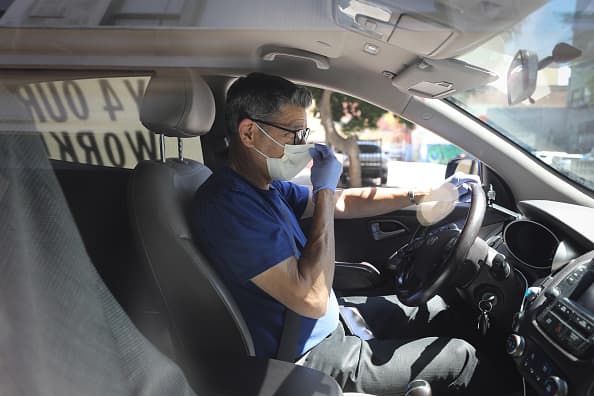A driver adjusts his face mask as Uber and Lyft drivers with Rideshare Drivers United and the Transport Workers Union of America conduct a ‘caravan protest’ outside the California Labor Commissioner’s office amidst the coronavirus pandemic on April 16, 2020 in Los Angeles, California. (Photo by Mario Tama/Getty Images)
Mario Tama
Self-employed workers trying to collect unemployment checks may get less pay than they think.
The $2.2 trillion federal coronavirus relief package enacted in March extended unemployment benefits to previously ineligible workers, such as self-employed individuals whose income evaporated as a result of the pandemic.
However, states must use the net (rather than gross) income that self-employed workers report on their tax returns to calculate their weekly jobless pay, according to a Labor Department directive issued April 27.
States use gross income to determine benefits for other workers.
Using the net-income formula could result in a big difference in unemployment pay for some self-employed people.
More than 33 million Americans have filed for unemployment benefits in the past seven weeks, according to the Labor Department.
Unemployment ‘hurdles’
Net income reflects total profit after costs and expenses that self-employed workers may deduct from their taxes, such as those associated with a vehicle, travel, business insurance or office supplies.
Deducting these costs, which could amount to a lot of money, reduces net income and, by extension, their overall tax burden. But it could also reduce unemployment benefits.
“[It] definitely presents additional hurdles for drivers,” said Mike Long, a spokesman for SEIU Local 721, a labor union representing more than 95,000 public-sector workers in southern California.
Gig workers such as Lyft and Uber drivers are currently organizing with the union through its Mobile Workers Alliance project.
Rideshare companies’ classification of drivers as independent contractors instead of employees pushes drivers to cover the costs associated with transporting passengers, Long said.
“If you expense a $60,000 [income] down to $10,000, your income in the eyes of the government is really $10,000 even though your gross was $60,000,” said Mark Pinto, secretary-treasurer of the Boston Musicians Association, a union representing roughly 1,700 professional musicians.
Self-employment ‘quagmire’
The net-income wrinkle comes on top of others, such as delays in the ability of states to accept and process applications from the self-employed and others newly eligible for unemployment benefits under the relief law.
Further, many self-employed workers derive income from both traditional W-2 wages and contract work reported on 1099 tax forms. But state unemployment offices generally look at the W-2 earnings, which may be more meager, to determine their unemployment benefits.
“Actors, artists, musicians and any people putting their living together [this way] are finding themselves in a real quagmire here,” Pinto said. “Their income doesn’t get recognized on both sides.”
Minimum unemployment benefits
There’s a silver lining for self-employed workers, though.
The coronavirus relief law, known as the CARES Act, establishes a minimum weekly benefit paid by a state to self-employed workers.
Even if a self-employed worker’s net income is fairly low relative to gross income, the individual would be eligible to collect at least half the state’s average weekly benefit, for a period of up to 39 weeks.
This payment would be made via the Pandemic Unemployment Assistance program created by the CARES Act.
